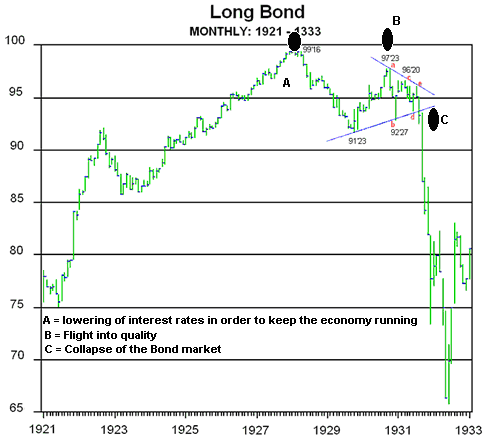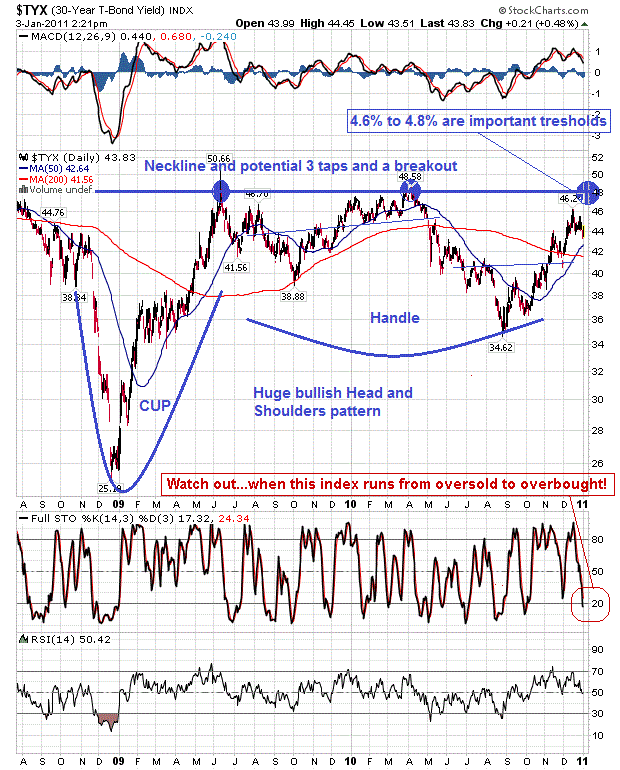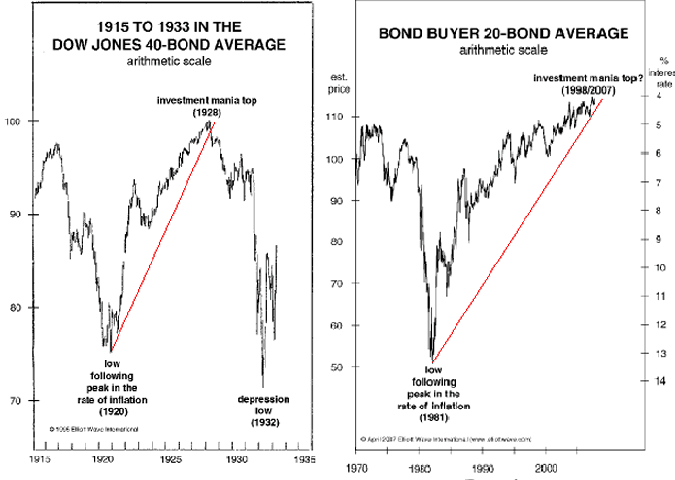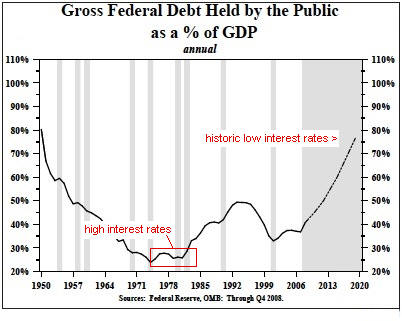|
 The interest rates will rise as a consequence
of Quantitative Easing and the explosive debt situation.
Although we cannot compare the actual situation with the 1920-30’s (in those
days the creation of money and credit was limited by Gold), I am convinced we
shall see a similar evolution of the Bond markets. See how FAST Bonds drop once
the down wave has been initiated (example Greece). The interest rates will rise as a consequence
of Quantitative Easing and the explosive debt situation.
Although we cannot compare the actual situation with the 1920-30’s (in those
days the creation of money and credit was limited by Gold), I am convinced we
shall see a similar evolution of the Bond markets. See how FAST Bonds drop once
the down wave has been initiated (example Greece).
Governments can print exponential amounts
of Money but only so much DEBT can been created...See the economist for the
World's Debt situation...more
 |
This is how it was during the last Great
Depression:
There are a number of reasons why
Treasury bond yields and the yield curve in general are likely to rise
sharply in 2010:...we have now (December 2009) broken through C and did break
down!

January 14, 2010 - This is how it is NOW in the
USA - see how similar with the Great Depression!!!
This is how it
will be during this Great Depression:

We have GLOBAL MARKETS. The
situation as described for the US is similar for the
EU.
Authorities can manipulate interest rates in the
short run and try to delay a rise in interest rates only for so long.
But this is the only action which is
possible. The world financial markets finally decide and dictate Interest
rates. What we are about to see is that Long term interest rates will push
up short term rates. The resistance level is 4,60% and it is in the
process to being broken. Notice the significance of the 4.0%
level. A huge reversal pattern is underway. The critical right side
resistance level has been 3.9%, well defended. The left side critical
resistance level has been 4.0% and 4.1% from late 2008. The trend is up,
accentuated by the stochastic index since October. Watch a breakout above
the important 4.0% level.

·
Huge borrowing requirements:
US treasury
borrowed over $1 trillion in the year to September 2008; it is expected to
borrow close to $2 trillion in the year to September 2009. That’s 13% of
US Gross Domestic Product. Not all of this is deficit; about $500 billion
is refinancing and another $500 billion is for bailout schemes, some of
which the US taxpayer may eventually see back. Still, in terms of GDP
that’s far more debt than the US capital market has ever been asked to
absorb, other than during World War II. At some point, “crowding out” must
occur; we certainly cannot assume that Asian central banks will want to
take the entire load, at interest rates less than zero in real terms.
· (Hyper)
Inflation.
The Fed appears to believe that the current recession will
bail the United States out of its inflation problem. The example is given
of Japan in the late 1990s, after which the Fed explains that they will
avoid the mistakes of the Bank of Japan, thus preventing damaging
deflation. Actually that seems to be wrong on two counts. The main mistake
in 1990s Japan was not monetary but fiscal; government spending was
allowed to expand inexorably, producing ever larger and larger deficits.
That mistake appears to be only too likely to be repeated here. The
difference is that the United States currently has a 1% Federal Funds rate
and 5% inflation, the approximate opposite of Japan in the early years of
its slump. With M2 money supply (the one the Fed will divulge) up at an
annual rate of 18.3% since the beginning of September it seems likely that
inflation will accelerate – as it did in the recessions of 1973-74 and
1979-80.
·
Rising real rates of return.
The yields on Treasury Inflation
Protected Securities have already risen from just over 1% to nearly 3%
since the beginning of 2008. Given the excess of bonds coming to the
market, it makes sense that real yields should rise. That in itself
suggests that conventional Treasury bonds are hopelessly overvalued – with
the 10-year TIPS yielding 2.82% and the 10 year Treasury 3.78% (yields as
of November 02 are even lower), the implied rate of US inflation over the
decade to 2018 is 0.96% per annum, for a total rise in prices by 2018 of
less than 10%. If you think that’s likely, I can get you a deal on
Brooklyn Bridge!
Thus Treasury bond and other prime bond yields can be expected to rise
sharply in 2009/2010/2011. This will cause losses to their holders. To the extent
that such holders are foreign central banks, the United States probably
doesn’t need to worry. Foreign central banks have been gentlemanly holders
of US debt through periods such as 2002-08 when the dollar has
depreciated; a rise in interest rates simply gives them another way of
making a loss. Personally if I were the Chairman of the People’s
Bank of China and Treasuries had lost me the kind of money they have in
the last five years I’d probably declare war on the US, but fortunately
central bankers are a phlegmatic and tolerant lot!
However domestic holders are a more serious problem. To the extent that
pension funds have losses on their holdings of bonds, they will need
to raise contributions; to the extent that insurance companies have
such losses they will need to raise premiums. Some entities will be
hedged, but by doing so they will have simply transferred the interest
rate risk to somebody else; by definition of derivatives the total
outstanding derivatives position must be zero, however large the
individual positions taken.
Assuming the $30 trillion state, mortgage and private corporate debt
outstanding has an average duration of 5 years, a fairly conservative
assumption, and neither the shape of the yield curve nor the premiums
payable for risk alter significantly by the end of 2009, a 1% rise to
4.74% in Treasury bond rates by December 2009 would cause a total loss to
investors in the $30 trillion of Federal, agency, mortgage and prime
corporate debt of 3.9% of the debt’s principal amount, or $1.17 trillion.
Not as bad as the credit losses.
However once rates start rising, they are likely to rise much more than
1%. To cause a loss of $3 trillion, the same as the estimated credit
losses, 10 year Treasury bond yields would have to rise to 6.43%. Hardly
an excessive assumption; 10-year Treasuries yielded 6.44% on average
during 1996, at the beginning of the Fed’s money bubble, in which year
inflation was 3.4%.
More extreme moves are certainly possible. In 1990, 10-year Treasuries
yielded an average of 8.55%, while inflation in that year was 6.3%. A rise
in the yield curve to an 8.55% 10-year Treasury yield would cost investors
$5.06 trillion, almost double the credit losses from subprime and its
brethren. Should we revert fully to the days when Paul Volcker was Fed
Chairman and get the 13.92% 10-year Treasury yield of 1981, a year in
which inflation was 8.9%, the cost to investors from the interest rate
rise alone (we can assume a few additional bankruptcies, I think) would by
$9.33 trillion, about two thirds of the current value of common stocks
outstanding and more than three times expected credit losses.
One can debate the probability of the various outcomes above. Inflation is
already around 5% and is unlikely to drop much, so the 1996 estimate for
the peak 10-year Treasury yield would seem low. On the other hand, while
inflation could well reach 8.9%, it seems unlikely that we will need to
push Treasury yields quite up to 1981’s Volckerian levels, at least not
within the next year. So the 1990 estimate is perhaps the best, involving
a loss to investors of around $5 trillion or a little over. Such a loss
will produce fewer calls for bailouts than the $3 trillion credit losses,
but just as much economic damage, albeit much of it unnoticed by the
general public.

|
To receive zero percent interest after
loaning your money to the government for one month is ridiculous.
 Government
typically follow the 'Turkey pattern'.
They pretend to care for the people during the 1000 first days but the next day
they are slaughtered. If they can't inflate away the debt, they call for a
debt moratorium. In Belgium 'the Unified debt-1945' is know of all
financial people. Government
typically follow the 'Turkey pattern'.
They pretend to care for the people during the 1000 first days but the next day
they are slaughtered. If they can't inflate away the debt, they call for a
debt moratorium. In Belgium 'the Unified debt-1945' is know of all
financial people.
During the Great Depression, all the conservative investors who held Bonds
lost all their savings as Bonds were either called in under the Moratorium
(Europe) or as the Dollar was devalued by 40% by Roosevelt.
The reduction in interest rates
which we have seen in the 1990's in Japan
and more recently in Western economies should theoretically stimulate demand to
reduce deflationary pressures. This however is not happening.
Monetarism does simply not work.
Investors are buying dangerous Government Debt
yielding less than safe Real Assets (Stocks)!?
Many who claim that there is justification for
today's bond yields are the same folks who claimed back in 2006 that home prices
had never before in history declined on a national level and any talk of a
bubble in real estate was therefore nonsense. Many of them are also the same
people who assured you in the year 2000 that prices of internet stocks were
fairly priced.
Rising interest rates are likely to be
symptomatic of the coming cash crunch. The revenue streams of the banks will dry
up and the industry will end up in an even worse shape.
Note how in from 1973 to 1980 interest
rates rose to peak in 1981 and the price of GOLD rose and peaked at the same
time. Or how this proof you have a
'Problem' if you are holding on to Bonds NOW!

|

> back to Bonds
© -
Goldonomic, Florida, USA -
 +1
(772)-905-2491
+1
(772)-905-2491 |